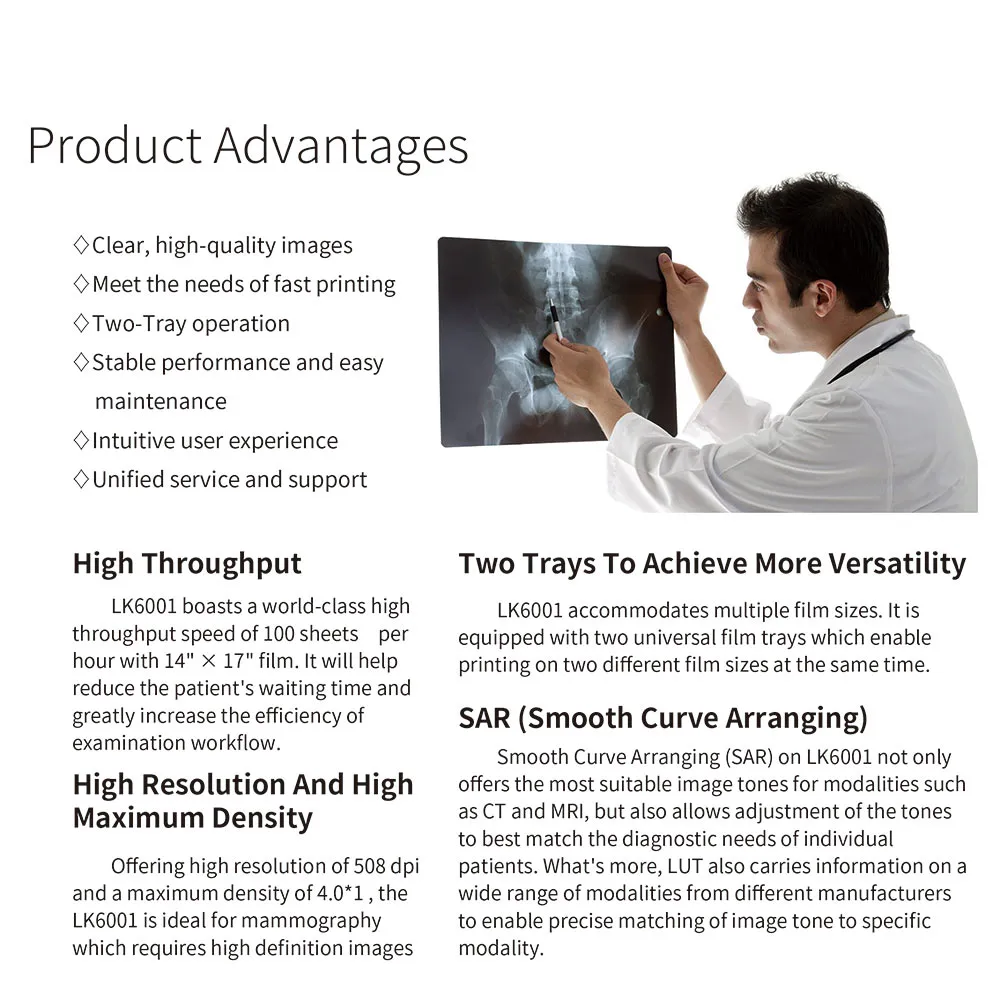


The medical imaging landscape is continuously evolving, driven by the demand for higher diagnostic accuracy, greater efficiency, and enhanced patient safety. Central to this evolution is the advent of advanced imaging technologies, particularly the imager laser, which has revolutionized the way medical images are processed and presented. Traditional wet-chemical film processing has largely been supplanted by dry laser technology, offering significant advantages in terms of speed, environmental impact, and image consistency. This shift represents a pivotal moment for hospitals, clinics, and diagnostic centers worldwide, enabling them to streamline workflows and deliver superior patient care. Understanding the intricate technology behind these devices, their operational benefits, and their integration into existing radiology infrastructures is paramount for healthcare providers looking to modernize their facilities.
The transition to digital imaging has necessitated robust and reliable hardcopy solutions, and this is where the role of the laser imager becomes indispensable. It bridges the gap between digital acquisition and physical film output, ensuring that high-resolution images from modalities such as CT, MRI, X-ray, and mammography can be accurately rendered onto film for various clinical needs. This technological advancement not only simplifies the imaging chain but also contributes to better patient outcomes by providing clear, durable, and precise diagnostic prints. The market for these advanced imaging solutions is experiencing substantial growth, fueled by increasing global healthcare expenditure, rising demand for diagnostic procedures, and a growing emphasis on environmentally friendly practices in medical facilities.
The Lucky Medical Dry Laser Imager Lk6001 stands as a testament to innovation in medical imaging, offering a robust and high-performance solution for radiology departments. This advanced dry laser imager is engineered to meet the demanding requirements of modern diagnostic environments, providing exceptional image quality without the need for wet chemical processing. Its compact design allows for flexible placement, making it suitable for facilities where space is a premium. The Lk6001 integrates seamlessly into existing PACS (Picture Archiving and Communication Systems) and RIS (Radiology Information Systems) environments through comprehensive DICOM 3.0 connectivity, ensuring efficient data transfer and workflow optimization.
Key features of the Lk6001 include its impressive resolution capabilities, consistently high maximum density (Dmax), and precise grayscale reproduction, which are crucial for accurate diagnoses across various imaging modalities. The device supports multiple film sizes, providing versatility for different clinical applications, from general radiography to specialized imaging. Its rapid print speed significantly reduces waiting times, enhancing patient throughput and operational efficiency. Furthermore, the Lk6001 is designed with user-friendliness in mind, featuring an intuitive interface and easy film loading, minimizing the learning curve for technical staff. The reliability and low maintenance requirements of this medical dry laser imager translate into reduced operational costs and increased uptime, making it a sound investment for any healthcare institution.
| Parameter | Specification |
|---|---|
| Technology | Direct Thermal Laser |
| Resolution | 600 DPI (Dots Per Inch) |
| Maximum Density (Dmax) | ≥ 3.8 |
| Minimum Density (Dmin) | ≤ 0.20 |
| Grayscale Levels | 14-bit (16384 levels) |
| Throughput (Films/hour) | Up to 70 films (14x17 inch) |
| Film Sizes Supported | 8x10, 10x12, 11x14, 14x17 inches |
| Network Connectivity | DICOM 3.0 compatible (RJ45 Ethernet) |
| Power Requirements | AC 100-240V, 50/60Hz |
| Operating Environment | 18-30°C, 20-80% RH (Non-condensing) |
The production of a high-precision medical device like a dry laser imager involves a meticulous manufacturing process, beginning with the selection of premium-grade components. This includes specialized thermal print heads, advanced laser diode arrays, precision optical systems, and sophisticated electronic control boards. Each component undergoes stringent quality checks upon arrival to ensure compliance with industry standards and performance specifications. The assembly process is typically carried out in controlled environments, often cleanrooms, to prevent contamination that could affect the imager's delicate optical and thermal mechanisms. Skilled technicians carefully integrate the various modules, ensuring precise alignment of the laser and optical path, which is critical for achieving high-resolution image output.
Following assembly, each laser imager radiology unit undergoes rigorous calibration and comprehensive testing protocols. This includes thermal calibration for consistent film density, optical calibration for image sharpness, and software calibration to ensure accurate DICOM image rendering. Performance validation involves printing test patterns and diagnostic images to verify resolution, grayscale accuracy, Dmax, Dmin, and uniformity across the entire film area. Compliance with international quality management standards such as ISO 13485 for medical devices is paramount, ensuring that every unit meets strict regulatory requirements for safety and efficacy. Environmental testing, including temperature and humidity cycling, is also conducted to confirm durability and reliability under various operating conditions. This exhaustive process guarantees that the final product, like the Lucky Medical Dry Laser Imager Lk6001, delivers consistent, reliable, and high-quality results in clinical settings, ultimately contributing to accurate diagnostic imaging.

The versatility of the medical dry laser imager makes it an indispensable tool across a broad spectrum of medical imaging applications. In general radiography, these imagers provide rapid and high-quality prints for X-ray images, assisting in the diagnosis of fractures, infections, and other skeletal conditions. For advanced modalities like CT and MRI, the high resolution and density range of a dry laser imager ensure that subtle anatomical details and pathological findings are accurately represented on film, critical for complex diagnoses such as tumor detection or neurological assessments. Mammography, requiring extremely high resolution and fine detail reproduction, particularly benefits from dedicated high-resolution imager laser systems, ensuring early detection of breast abnormalities.
Beyond diagnostic accuracy, the advantages of dry laser imaging extend to operational and environmental benefits. Eliminating wet chemical processing means no darkroom, no hazardous chemical waste, and no need for specialized plumbing or ventilation systems, significantly reducing infrastructure costs and environmental impact. This also translates to a safer working environment for staff. The speed and efficiency of a dry laser camera radiology system improve patient throughput, reducing wait times and enhancing the overall patient experience. Furthermore, the longevity and stability of dry films, which are less prone to degradation than chemically processed films, ensure that patient records remain clear and diagnostic quality is preserved over time. These operational efficiencies and environmental considerations underscore why dry laser technology has become the standard in modern radiology departments globally.
When selecting a dry laser imager, healthcare providers must consider several factors, including image quality, throughput, film size compatibility, connectivity, footprint, and total cost of ownership. While many manufacturers offer dry laser solutions, a comparative analysis reveals distinct advantages. For instance, some imagers might prioritize speed, while others excel in ultra-high resolution for specialized applications like mammography. Evaluating specific departmental needs against the technical specifications of available models is crucial. Factors like the anticipated daily film volume, the range of imaging modalities to be supported, and the available physical space all play a significant role in the decision-making process. Moreover, the reputation of the manufacturer for reliability, customer support, and timely service should be heavily weighted.
Lucky Medical offers comprehensive support for customizing solutions tailored to unique facility requirements. This includes advising on optimal laser imager models, integration strategies with existing IT infrastructure, and providing training for technical staff. For instance, a large university hospital might require multiple high-throughput imagers integrated into a centralized PACS, while a smaller clinic may benefit from a single, compact unit that can handle diverse imaging needs. Our experts work closely with clients to understand their specific workflow, patient volume, and budget constraints to design a hardcopy solution that optimizes efficiency and diagnostic quality. This bespoke approach ensures that clients receive not just a product, but a complete imaging solution that enhances their operational capabilities and aligns with their long-term strategic goals.
| Feature | Lucky Medical Lk6001 | Competitor A (High-End) | Competitor B (Entry-Level) |
|---|---|---|---|
| Resolution | 600 DPI | 650 DPI (for Mammography) | 320 DPI |
| Dmax | ≥ 3.8 | ≥ 4.0 | ≥ 3.0 |
| Throughput (14x17 inch) | Up to 70 films/hour | Up to 100 films/hour | Up to 40 films/hour |
| Film Sizes | 8x10 to 14x17 inches | Full range, including mammography-specific | Limited range (e.g., 10x12, 14x17) |
| Footprint | Compact Desktop/Tower | Larger, Floor-standing | Very Compact Desktop |
| Price Point (Relative) | Mid-range, excellent value | Premium | Economical |
At Lucky Medical, we understand that investing in a dry laser imager is a critical decision for any healthcare facility. Our commitment to trustworthiness is reflected in our robust support infrastructure and comprehensive warranty programs. All Lucky Medical Dry Laser Imagers, including the Lk6001, come with a standard 1-year warranty covering parts and labor, with extended warranty options available to provide long-term peace of mind. Our global network of certified service engineers is equipped to provide prompt installation, preventative maintenance, and troubleshooting support, ensuring minimal downtime for your diagnostic operations. We pride ourselves on a rapid response time, typically within 24-48 hours for critical issues, understanding the urgency inherent in medical environments. Our technical support team is available via phone and email to assist with any operational queries or technical challenges, ensuring that your team can maximize the utility of your imaging equipment without interruption.
Delivery of the Lucky Medical Dry Laser Imager Lk6001 is typically completed within 4-6 weeks from order confirmation, depending on the destination and specific configuration requirements. We manage all logistics, including customs clearance and transportation, to ensure a smooth and timely delivery process. Upon arrival, our authorized service partners will handle the professional installation and initial calibration of the laser imager radiology unit, along with comprehensive training for your staff on its operation and basic maintenance. Our dedication to client satisfaction extends beyond the sale, fostering long-term partnerships built on reliability, superior product performance, and unwavering customer support. This holistic approach ensures that medical facilities can confidently rely on Lucky Medical for their critical imaging needs for years to come.
The imager laser represents a cornerstone of modern medical diagnostics, offering unparalleled image quality, operational efficiency, and environmental responsibility. The Lucky Medical Dry Laser Imager Lk6001 embodies these advancements, providing a reliable, high-performance solution that integrates seamlessly into today's complex radiology workflows. By eliminating the need for wet processing, the Lk6001 not only streamlines operations but also aligns with the growing global emphasis on sustainable healthcare practices. Its robust design, precise imaging capabilities, and comprehensive support system make it an ideal choice for healthcare facilities seeking to enhance their diagnostic capabilities and improve patient care. Choosing an advanced dry laser camera radiology solution like the Lk6001 is an investment in future-proof technology, ensuring consistent, high-quality imaging output crucial for accurate clinical decision-making.
This is the first article
Lucky Medicinal Cold-Forming Composite Material
Types of Solar Backsheet Materials for Enhanced Durability
If you are interested in our products, you can choose to leave your information here, and we will be in touch with you shortly.






